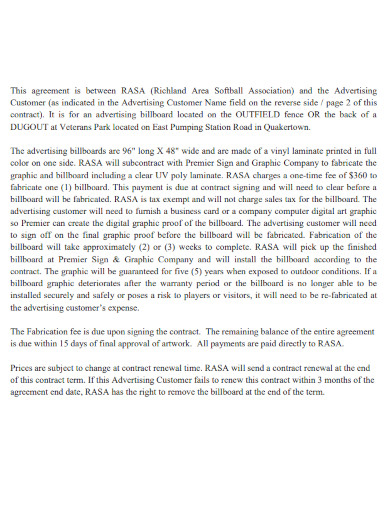11+ SAMPLE Advertising Agreement
-

Website Advertising Agreement Template
download now -

Restaurant Online Advertising Agreement Template
download now -

Advertising Reseller Agreement Template
download now -

Simple Advertising Agency Agreement Template
download now -

Advertising Agency Services Agreement Template
download now -

Sample Hoarding Advertising Agreement
download now -

Web Banner Advertising Agreement
download now -

Digital Advertising Agreement
download now -

Video Board Advertising Agreement
download now -

Sample Advertising Billboard Agreement
download now -

Paid Advertising Management Agreement
download now -

Sample Advertising Agreement Template
download now
FREE Advertising Agreement s to Download
11+ SAMPLE Advertising Agreement
What is Advertising Agreement?
How do you write a Advertising Agreement?
What Should be in an Advertising Agreement?
How to create an Advertising Agreement?
What is the Main Purpose of Advertising Agreement?
Why is an Advertising Agreement Important?
How is payment addressed in an Advertising Agreement?
What is the purpose of a confidentiality clause in an Advertising Agreement?
sample document that outlines the terms and conditions between parties involved in an advertising partnership. It serves as a roadmap for collaborative ventures, ensuring clarity and fairness. This agreement typically includes details such as the scope of advertising services, payment terms, duration of the partnership, responsibilities of each party, and any other relevant clauses to govern the advertising relationship. It acts as a safeguard, defining expectations and minimizing potential disputes. Crafting a comprehensive Advertising Agreement is crucial for fostering successful and mutually beneficial advertising collaborations.
How do you write a Advertising Agreement?
Writing an effective Advertising Agreement involves careful consideration of the terms and conditions to ensure clarity and fairness. Here’s a step-by-step guide to help you create a comprehensive Advertising Agreement:
1. Introduction:
Start with a clear and concise introduction, identifying the parties involved and the purpose of the agreement.
2. Scope of Services:
Clearly define the advertising services to be provided. Specify the type of ads, platforms, and any restrictions.
3. Duration and Termination:
Outline the duration of the agreement and conditions under which either party can terminate the Contracts And Agreements.
4. Payment Terms:
Clearly state the compensation structure, including payment amounts, frequency, and any other relevant financial details.
5. Responsibilities:
Specify the responsibilities of each party. This could include ad creation, placement, monitoring, and reporting.
6. Intellectual Property:
Address the ownership of creative materials, ensuring that both parties understand the usage rights and limitations.
7. Confidentiality:
Include a confidentiality clause to protect sensitive information shared during the collaboration.
8. Representations and Warranties:
Outline the assurances each party provides regarding their ability to fulfill the terms of the agreement.
9. Indemnification:
Define the responsibilities of each party in case of legal claims or liabilities arising from the advertising activities.
10. Dispute Resolution:
Include a section on how disputes will be resolved, whether through mediation, arbitration, or legal proceedings.
11. Miscellaneous Provisions:
Address any other relevant details, such as governing law, amendments, and force majeure.
12. Signatures:
Provide space for the signatures of all involved parties, indicating their agreement to the terms outlined.
You May Also See SAMPLE Agency Agreements
In an Advertising Agreement, it’s essential to cover various aspects to ensure clarity and protection for all parties involved. Here’s a comprehensive list of what should be included:
1. Parties Involved:
Clearly identify and provide details about the parties entering into the agreement.
2. Scope of Services:
Define the specific advertising services to be provided, including details about ad types, platforms, and any creative requirements.
3. Duration and Termination:
Specify the start and end dates of the agreement, as well as conditions under which either party can terminate the contract.
4. Payment Terms:
Outline the compensation structure, including payment amounts, schedule, and any applicable taxes or fees.
5. Responsibilities:
Clearly outline the responsibilities of each party, including tasks related to ad creation, placement, monitoring, and reporting.
6. Intellectual Property:
Address the ownership of creative materials, specifying usage rights and any limitations on intellectual property.
7. Confidentiality:
Include a confidentiality clause to protect sensitive information shared during the advertising collaboration.
8. Representations and Warranties:
Clearly state the assurances each party provides regarding their ability to fulfill the terms of the agreement.
9. Indemnification:
Define the responsibilities of each party in case of legal claims or liabilities arising from the advertising activities.
10. Cancellation and Changes:
Specify procedures for canceling or modifying advertising campaigns and any associated fees or penalties.
11. Performance Metrics:
Define key performance indicators (KPIs) and metrics used to measure the success of the advertising campaign.
12. Dispute Resolution:
Include a section on how disputes will be resolved, whether through mediation, arbitration, or legal proceedings.
13. Termination and Renewal:
Detail the conditions under which the agreement can be terminated, renewed, or renegotiated.
14. Governing Law:
Specify the jurisdiction and governing law applicable in case of legal disputes.
15. Amendments:
Outline the process for making changes or amendments to the agreement and any requirements for written consent.
16. Force Majeure:
Include a provision addressing unforeseen events or circumstances that may affect the performance of the agreement.
17. Signatures:
Provide space for the signatures of all parties involved, indicating their agreement to the terms outlined in the Advertising Agreement.
Ensure that the language used is clear and understandable, and consider seeking legal advice to ensure compliance with relevant laws and regulations.
You May Also See SAMPLE Advertising Contracts.
How to create an Advertising Agreement?
Creating an effective Advertising Agreement involves several steps to ensure that all parties involved are clear on the terms and conditions of the advertising partnership. Here’s a step-by-step guide to help you create an Advertising Agreement:
1. Title and Introduction:
Start with a clear title that reflects the purpose of the agreement.
Introduce the agreement, identifying the parties involved and the overall objective of the advertising collaboration.
2. Scope of Services:
Clearly define the advertising services to be provided. Specify the type of ads, platforms, and any specific requirements for creative content.
3. Duration and Termination:
Specify the start and end dates of the agreement.
Outline conditions under which either party can terminate the contract and any associated consequences.
4. Payment Terms:
Clearly outline the compensation structure, including payment amounts, frequency, and any applicable taxes or fees.
Specify the method of payment and any late payment penalties.
5. Responsibilities:
Clearly define the responsibilities of each party involved in the advertising collaboration.
Detail tasks related to ad creation, placement, monitoring, and reporting.
6. Intellectual Property:
Address the ownership of creative materials, specifying usage rights and any limitations on intellectual property.
7. Confidentiality:
Include a confidentiality clause to protect sensitive information shared during the advertising collaboration.
What is the purpose of a confidentiality clause in an Advertising Agreement?
A confidentiality clause protects sensitive information shared during the advertising collaboration, ensuring that proprietary or confidential business information remains confidential and is not disclosed to third parties.
You May Also See SAMPLE Website Advertising Agreement
In conclusion, crafting a comprehensive Advertising Agreement is vital for successful collaborations. This guide has provided essential tips, emphasizing clarity, legal protection, and financial transparency. By outlining responsibilities, addressing intellectual property, and incorporating dispute resolution mechanisms, your agreement becomes a strategic tool for fostering effective and mutually beneficial advertising partnerships. Follow these tips to ensure a solid foundation for your agreements.
